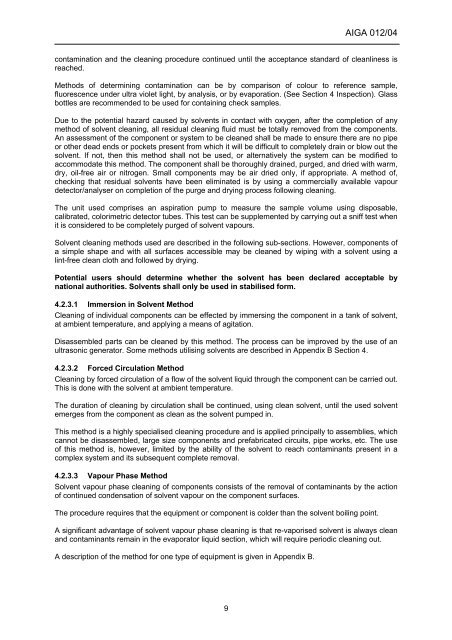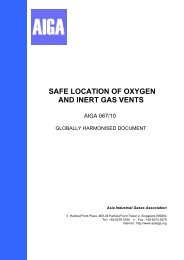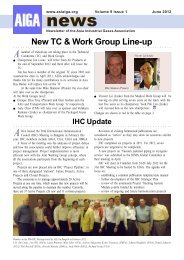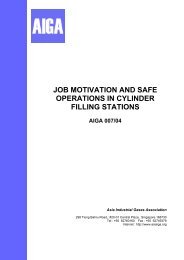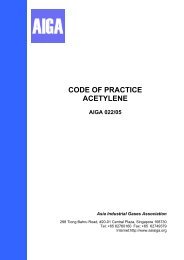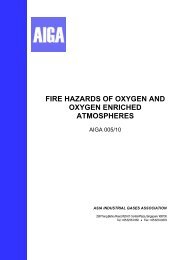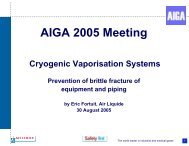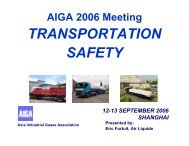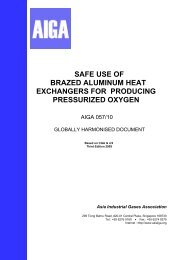CLEANING OF EQUIPMENT FOR OXYGEN SERVICE - AIGA
CLEANING OF EQUIPMENT FOR OXYGEN SERVICE - AIGA
CLEANING OF EQUIPMENT FOR OXYGEN SERVICE - AIGA
Create successful ePaper yourself
Turn your PDF publications into a flip-book with our unique Google optimized e-Paper software.
9<br />
<strong>AIGA</strong> 012/04<br />
contamination and the cleaning procedure continued until the acceptance standard of cleanliness is<br />
reached.<br />
Methods of determining contamination can be by comparison of colour to reference sample,<br />
fluorescence under ultra violet light, by analysis, or by evaporation. (See Section 4 Inspection). Glass<br />
bottles are recommended to be used for containing check samples.<br />
Due to the potential hazard caused by solvents in contact with oxygen, after the completion of any<br />
method of solvent cleaning, all residual cleaning fluid must be totally removed from the components.<br />
An assessment of the component or system to be cleaned shall be made to ensure there are no pipe<br />
or other dead ends or pockets present from which it will be difficult to completely drain or blow out the<br />
solvent. If not, then this method shall not be used, or alternatively the system can be modified to<br />
accommodate this method. The component shall be thoroughly drained, purged, and dried with warm,<br />
dry, oil-free air or nitrogen. Small components may be air dried only, if appropriate. A method of,<br />
checking that residual solvents have been eliminated is by using a commercially available vapour<br />
detector/analyser on completion of the purge and drying process following cleaning.<br />
The unit used comprises an aspiration pump to measure the sample volume using disposable,<br />
calibrated, colorimetric detector tubes. This test can be supplemented by carrying out a sniff test when<br />
it is considered to be completely purged of solvent vapours.<br />
Solvent cleaning methods used are described in the following sub-sections. However, components of<br />
a simple shape and with all surfaces accessible may be cleaned by wiping with a solvent using a<br />
lint-free clean cloth and followed by drying.<br />
Potential users should determine whether the solvent has been declared acceptable by<br />
national authorities. Solvents shall only be used in stabilised form.<br />
4.2.3.1 Immersion in Solvent Method<br />
Cleaning of individual components can be effected by immersing the component in a tank of solvent,<br />
at ambient temperature, and applying a means of agitation.<br />
Disassembled parts can be cleaned by this method. The process can be improved by the use of an<br />
ultrasonic generator. Some methods utilising solvents are described in Appendix B Section 4.<br />
4.2.3.2 Forced Circulation Method<br />
Cleaning by forced circulation of a flow of the solvent liquid through the component can be carried out.<br />
This is done with the solvent at ambient temperature.<br />
The duration of cleaning by circulation shall be continued, using clean solvent, until the used solvent<br />
emerges from the component as clean as the solvent pumped in.<br />
This method is a highly specialised cleaning procedure and is applied principally to assemblies, which<br />
cannot be disassembled, large size components and prefabricated circuits, pipe works, etc. The use<br />
of this method is, however, limited by the ability of the solvent to reach contaminants present in a<br />
complex system and its subsequent complete removal.<br />
4.2.3.3 Vapour Phase Method<br />
Solvent vapour phase cleaning of components consists of the removal of contaminants by the action<br />
of continued condensation of solvent vapour on the component surfaces.<br />
The procedure requires that the equipment or component is colder than the solvent boiling point.<br />
A significant advantage of solvent vapour phase cleaning is that re-vaporised solvent is always clean<br />
and contaminants remain in the evaporator liquid section, which will require periodic cleaning out.<br />
A description of the method for one type of equipment is given in Appendix B.


